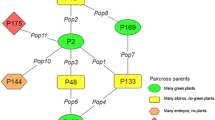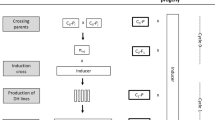Summary
Chromosome doubling has been a limiting factor for production of doubled-haploids, a means of obtaining fruly homozygous individuals, and a time-saving alternative to repeated selfing for the creation of inbred lines. The existence of genetic, environmental and genotype × environment interaction effects on chromosome doubling ability of sugarbeet (Beta vulgaris L.) haploids was investigated. Haploids were derived from four distinct, highly heterozygous diploid populations through in vitro culture of unpollinated ovules. Ovule-derived plants were treated with colchicine to double their chromosome complement. Environmental effects were determined from replication of the experiment at seven dates. Both genetic and environmental factors were found to affect chromosome doubling ability of sugarbeet haploids. No significant interaction between genotype and environment was identified. The presence of genetic effects on chromosome doubling ability is discussed with regard to its implications on breeding programs.
Similar content being viewed by others
References
Blakeslee, A.F. & A.G. Avery, 1937. Method of inducing doubling of chromosomes in plants. J. Hered. 28: 393–411.
Bosemark, N.O., 1971. Haploids and homozygous diploids, triploids and tetraploids in sugarbeet. Hereditas 69: 355–360.
Bossoutrot, D. & D. Hosemans, 1985. Gynogenesis in Beta vulgaris L.. From in vitro culture of unpollinated ovules to the production of doubled haploid plants in soil. Plant Cell Rep. 4: 300–303.
Bui Dang Ha, D. & J. Pernès, 1982. Androgenesis in pearl millet; analysis of plants obtained from microspore culture. Z. Pflanzenphysiol. 108: 317–327.
Bullock, W.P., P.S. Baenziger, G.W. Schaeffer & P.J. Bottino, 1982. Anther culture of wheat (Triticum aestivum L.) F1s and their reciprocal crosses. Theor. Appl. Genet. 62: 155–159.
D'Halluin, K. & B. Keimer, 1986. Production of haploid sugarbeets (Beta vulgaris L.) by ovule culture. p. 307–309. In: W. Horn, C.W. Jensen, W. Odenbach & O. Schieder (Eds). Genetic Manipulation in Plant Breeding. Walter de Gruyter, Berlin.
Guiderdoni, E., 1991. Gametic selection in anther culture of rice (Oryza sativa L.). Theor. Appl. Genet. 81: 406–412.
Hayward, M.D., A. Olesen, I.K. Due, R. Jenkins & P. Morris, 1990. Segregation of isozyme marker loci amongst androgenetic plants of Lolium perenne L.. Plant Breed. 104: 68–71.
Jensen, C.J., 1974. Chromosome doubling techniques in haploids. p. 153–190. In: C.J. Jensen (Ed). Haploids in Higher Plants: Advances and Potential. University of Guelph Press.
Kruse, A., 1963. Pure lines and their hybrids in beets Beta vulgaris L.. Kgl. Vet. og Landbohojsk Årsskr. 42–53.
Orton, T.J. & M.A. Browers, 1985. Segregation of genetic markers among plants regenerated from cultured anthers of broccoli (Brassica oleracea var. ‘italica’). Theor. Appl. Genet. 69: 637–643.
Powell, W., 1988. Diallel analysis of barley anther culture response. Genome 30: 152–157.
Ross, R.W., L.A. Dionne, & R.W. Hougas, 1967. Doubling the chromosome number of selected Solanum genotypes. Eur. Potato J. 10: 37–52.
SAS Institute Inc., 1985. SAS User's Guide: Statistics, Version 5 Edition. Cary, NC: SAS Institute Inc.
Snape, J.W., E. Simpson, B.B. Parker, W. Friedt & B. Foroughi-Wehr, 1986. Criteria for the selection and use of doubled haploid systems in cereal breeding programmes. p. 217–229. In: W. Horn, C.W. Jensen, W. Odenbach & O. Schieder (Eds). Genetic Manipulation in Plant Breeding. Walter de Gruyter, Berlin.
Speckmann, G.J., 1975. Methods for chromosome doubling in fodder crops. p. 90–95. In: B. Nuesch (Ed). Ploidy in Fodder Crops. Report of the meeting of the Eucarpia fodder crop section, April 23–25, 1975, Zürich-Reckenholz.
Thiebaut, J., K.J. Kasha & A. Tsai, 1979. Influence of development stage, temperature and plant hormones on chromosome doubling of barley haploids using colchicine. Can. J. Bot. 57: 480–483.
Thompson, D.M., K. Chalmers, R. Waugh, B.P. Forster, W.T.B. Thomas, P.D.S. Caligari & W. Powell, 1991. The inheritance of genetic markers in microspore-derived plants of barley Hordeum vulgare L.. Theor. Appl. Genet. 81: 487–492.
Author information
Authors and Affiliations
Rights and permissions
About this article
Cite this article
Ragot, M., Steen, P. Genetic and environmental effects on chromosome doubling of sugarbeet (Beta vulgaris L.) haploids. Euphytica 63, 233–237 (1992). https://doi.org/10.1007/BF00024549
Received:
Accepted:
Issue Date:
DOI: https://doi.org/10.1007/BF00024549




